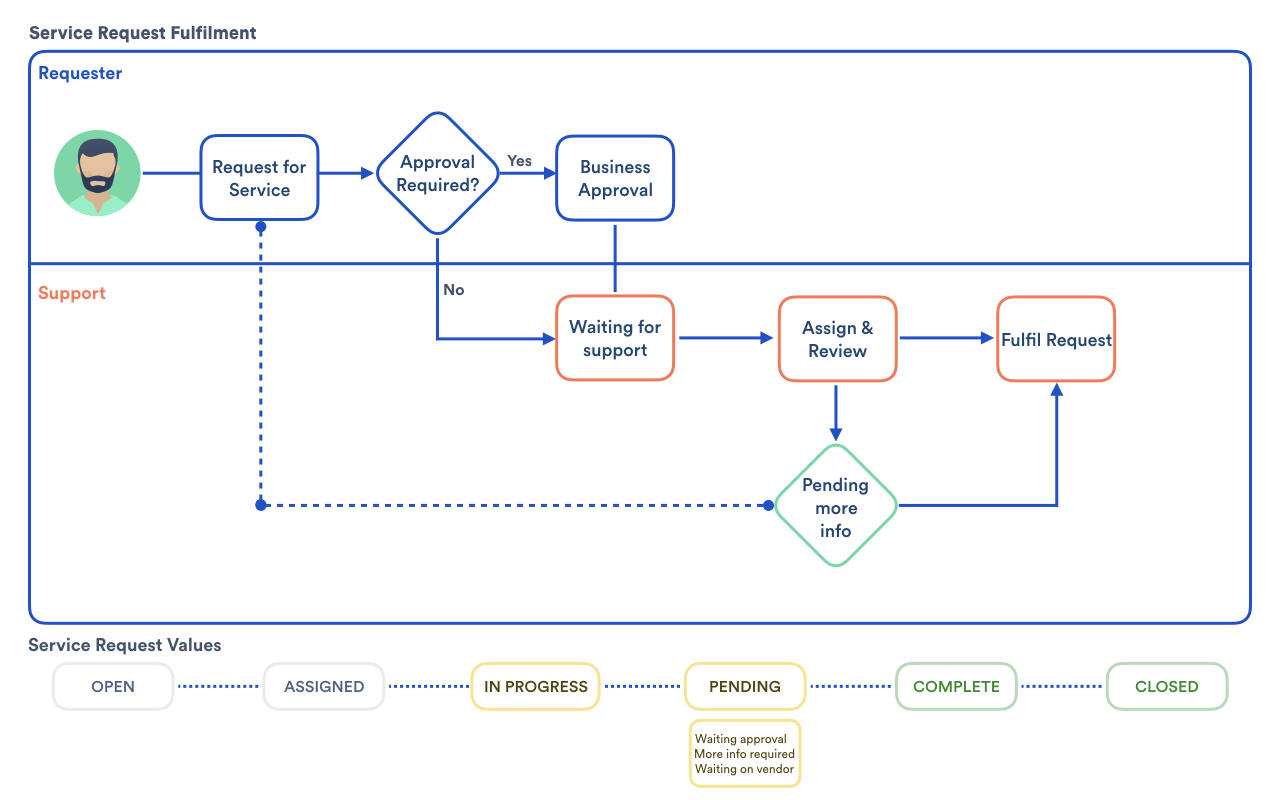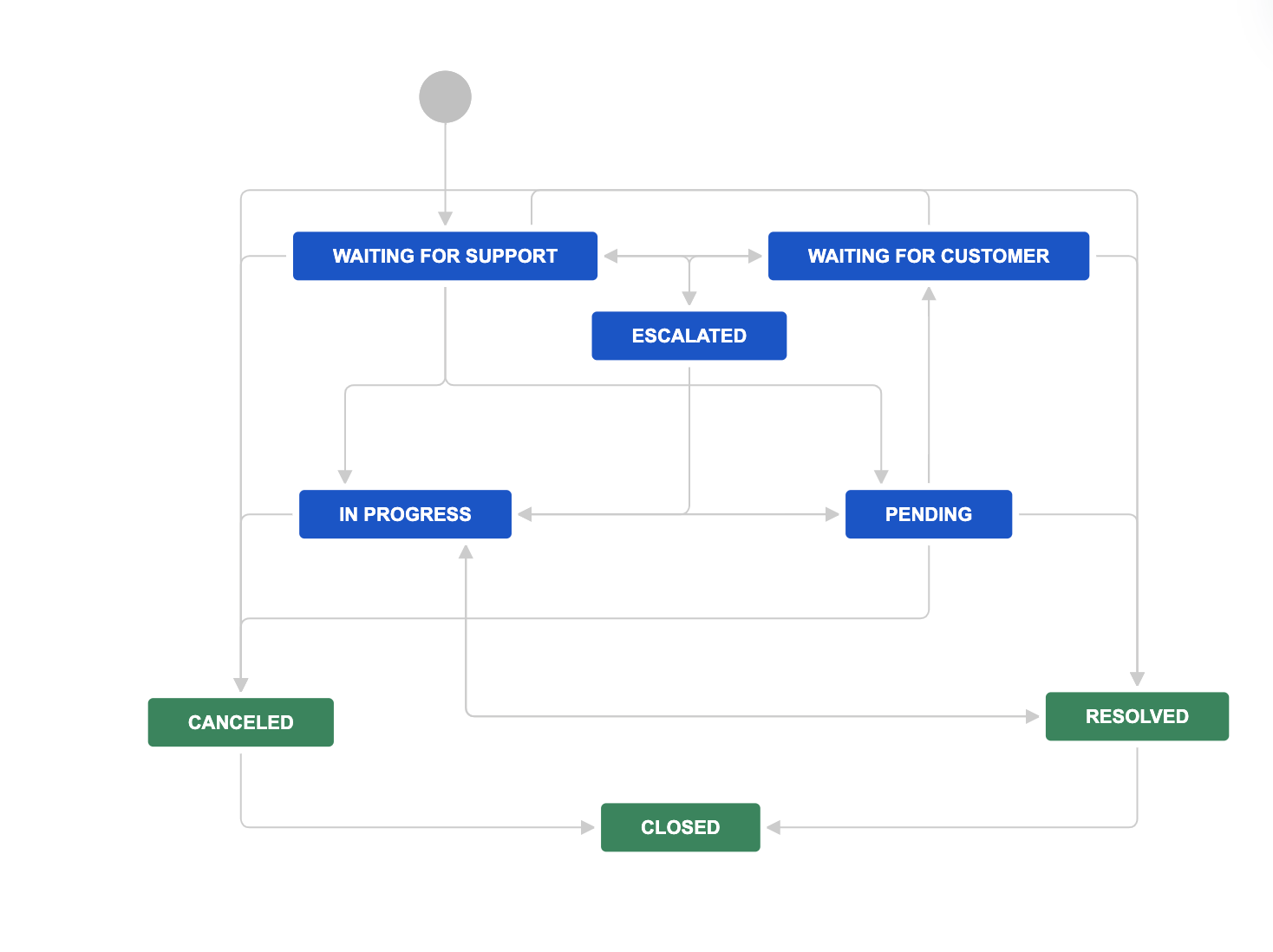Fulfilling service requests with your IT service desk
The scope of service requests in Information Technology Infrastructure Library (ITIL) is large. Tasks can range from resetting a password to onboarding a new hire. Service requests include customer comments, complaints, or other requests for information.
The IT Service Desk template comes with a few pre-built service request types. We set these up to help your service desk agents handle common service requests.
The service request fulfillment process:
- manages customer expectations
- speeds up request resolution
- standardizes any approval processes
Effective service request management reduces the bureaucracy and cost of maintaining IT services.
This page describes some best practices for fulfilling service requests using Jira Service Management. You may seek formal training in how to make ITIL recommendation work best for your business.
Service request fulfillment process
The information needed to capture and resolve service requests varies. But, you can standardize the process for fulfilling these requests.
The IT Service Desk template associates certain requests with a service request fulfillment workflow. We set up the workflow to complement the following service request fulfillment process. Use it as a jumping off point for your service desk.
The service request fulfillment process, in brief:
- A customer requests help from your service catalog or via email.
- The service desk assesses the request alongside pre-defined approval and qualification processes. If needed, they send the request for financial or business approval.
- A service desk agent works to fulfill the service request, or forwards the request to someone who can.
- After resolving the request, the service desk closes the ticket. The agent consults the customer to make sure they are satisfied.
Setup for service request fulfillment in Jira Service Desk
Configure the workflow and fields with the service request workflow add-on
We used the ITIL framework for change management to build a workflow for Jira Service Management: https://marketplace.atlassian.com/plugins/com.atlassian.servicedesk.servicerequest/server/overview.
You can use this add-on as a template to help you build your own service request fulfillment process.
To use the workflow from the Marketplace:
- Log in as a user that has the Jira administrator global permission, and follow the instructions listed here to import a workflow.
- To add the workflow fields to your change issues, activate the screen by following the instructions here: Defining a screen.
Service request fulfillment workflow
Tips for creating service request forms on your portal
- Begin with the most common requests. Choose ones that are simple and easy to fulfill. This delivers immediate value to customers. It allows the service desk team to learn as they build out future phases of the service catalog.
- Document all the requirements for a service request before adding it to the catalog. These include question data, the approval process, fulfillment procedures, the fulfillment team, process owners, SLAs, reports, and so on. This allows the IT team to better manage the request type over time.
- Capture the data needed to start fulfilling the request. But, don't overload the customer with too many questions.
- Work with stakeholders to standardize the approval process, where possible. For example, pre-approve all requests for new monitors. Or, assign software approvals to the customer's manager.
- Document any knowledge base information that might allow customers to service their own request. Record this in a linked Confluence space. If you do, customers can view articles while they search your portal. Read more about creating a knowledge base.
- Review your team's performance in fulfilling requests. Adjust your SLAs, requirements, and training to improve customer satisfaction.
- Create reports to help manage the lifecycle of a service request offering. These trends can uncover forms that are no longer needed, too complex, or insufficient.
Read more about creating reports.
Default form fields for service requests
Jira Service Management allows you to customize the fields of information collected from customers. Additionally, you can customize the fields of information used by your agents. Jira Service Management does this through issue type fields and screens. Fields help agents fulfill the request, discuss with vendors , and categorize requests.
By default, we include the following fields in your agents' view of a service request:
| Field name | Description |
|---|---|
| Summary | A short description of the request. |
| Reporter | The person who submitted the request. |
| Component/s | Segments of your IT infrastructure that relate to the request. For example, "Billing services" or "VPN server". These are used for labeling, categorization, and reporting. |
| Attachment | Files or images added to the request. |
| Description | A long, detailed description of the request. |
| Linked Issues | A list of other requests that affect or are effected by the request. If your business uses other Atlassian products, this list may include linked development issues. |
| Assignee | The service desk agent assigned to fulfill the request. |
| Priority | The importance of the request's resolution, usually in regards to your business needs and goals. Sometimes, priority is calculated by impact and urgency. |
| Labels | A list of additional custom labels used for categorizing or querying records. |
| Request participants | A list of extra customers or vendors who take part in resolving the request. |
| Approvers | A list of business or financial contacts responsible for approving the service request. |
| Organizations | A list of customer or vendor groups interested in the request's resolution. |
Extra form fields recommended by ITIL
ITIL recommends a few more fields for their in-depth processes. The IT Service Desk template doesn't include these by default. This is because IT teams who use Jira Service Management don't often use these fields. If needed, you can include these fields or add custom fields. Find out more about fields in Jira.
ITIL also recommends including the following fields:
| Field name | Description |
|---|---|
| Impact | The effect of the service request, usually in regards to service level agreements. |
| Urgency | The time available before the business feels the service request's impact. |
| Pending reason | A short description or code that indicates why the service request is not progressing. |
| Product categorization | A category of IT asset or system that the request effects. |
| Operational categorization | A category of action or function required to fulfill the request. |
Learn more about IT service management (ITSM)
Get more tips and tricks for successful ITSM, view case studies, and learn how to take your service desk to the next level.

